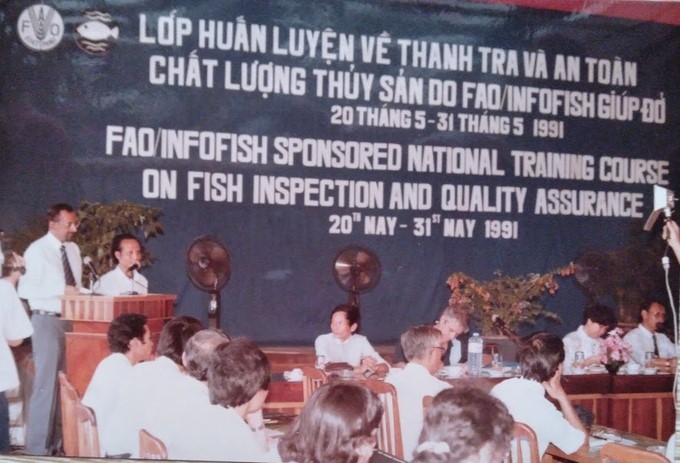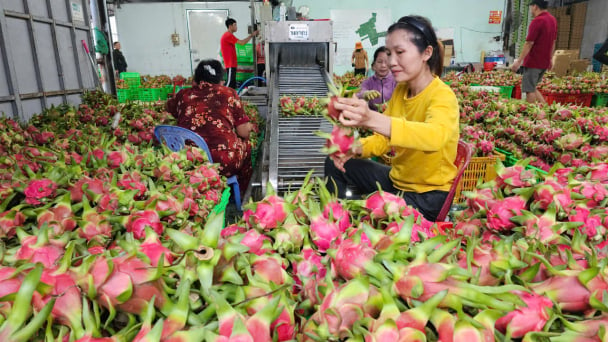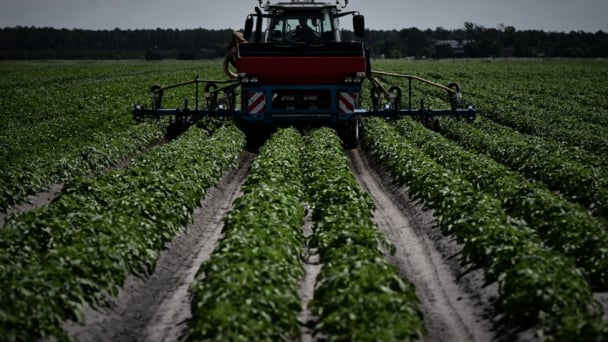June 18, 2025 | 16:19 GMT +7
June 18, 2025 | 16:19 GMT +7
Hotline: 0913.378.918
June 18, 2025 | 16:19 GMT +7
Hotline: 0913.378.918
Editor's note: On the occasion of the 30th anniversary of the establishment and development of the Department of Quality, Processing, and Market Development (Ministry of Agriculture and Rural Development), Vietnam Agriculture Newspaper is honored to introduce a series of articles by former Minister of Fisheries Ta Quang Ngoc about a starting period with new thinking that creates a solid foundation and contributes to bringing Vietnamese agricultural products to more than 180 countries and territories as of today.
The reason stems from the current situation of product damage, which poses a potential risk of causing illness to users. That situation requires a major change in seafood quality control and hygiene.
In the US, Congress requested the National Marine Fisheries Service (NMFS) to develop a "Model Fisheries Monitoring Project" to design a mandatory seafood inspection program based on HACCP approach. The work was conducted in cooperation with the Food and Drug Administration (FDA) and the United States Department of Agriculture (USDA).

The opening ceremony of the first national training class on inspection and safety and hygiene sponsored by FAO and INFOFISH. Documentary photo of former Minister of Fisheries Ta Quang Ngoc.
The project's conclusions were quickly examined by this country's National Academy of Sciences (NAS) to make official recommendations on management innovation. These recommendations were submitted to the National Assembly. And the HACCP approach was assigned by the US Congress to apply to this country's fisheries in the late 1980s.
Accordingly, hygiene hazards for consumers come from three main sources: factory hygiene, food hygiene, and dishonesty in trade. Therefore, the designed HACCP system must include all factors overcoming risks from all three sources to avoid all hazards for consumers. All factors related to seafood safety are divided into groups according to origin: the environment, processing, circulation and distribution, and the consumer community.
From August 26–30, 1991, the International Conference on Quality Safety in the Fisheries Industry was held in Lyngby City, Denmark, with the participation of more than 200 scientists and business delegates from 41 countries. After lively discussion sessions on all issues of quality and methods of evaluating and controlling quality in production and processing, the conference came to a number of conclusions and recommendations. Of which, the first important point is: "HACCP is currently the best system for producing food with reliable microbiological safety. It must be applied to the fisheries industry and cover all aspects of seafood quality from harvest to final consumption. HACCP can be effectively applied to control seafood processing in developing countries, whether industrially or manually."
The world fisheries map has changed greatly since the 1982 International Convention on the Law of the Sea (UNCLOS) was signed and implemented. The landscape of the world seafood trade has also changed.
Large amounts of seafood were exploited and processed in many developing countries and exported to markets in developed industrial countries. In developing countries at that time, there were mainly small, scattered fisheries and limited investment in seafood processing enterprises, making it difficult to keep raw materials fresh and preserve products.
Also, since the 1980s, aquaculture has begun to develop strongly. Farmed products gradually dominated the world seafood market and were a strength in increasing the export turnover of many countries. However, the use of artificial feed, materials and chemicals to treat pond environments, and medicine types used to treat livestock diseases was increasing. Residues of harmful substances in products are always a huge concern for consumers. Limitations in inspection and product hygiene assurance in these countries are also a concern.
Therefore, after studying the current situation of seafood quality control in some countries in this group, FAO has developed projects to deploy simultaneously in different regions of the world. Education and training are important activities. A typical example of international support in the field of seafood inspection and quality control is the UNDP/FAO INT/90/026 Project, which is a highly integrated training program on the hygiene and safety of seafood and seafood products.
In just two and a half years (from October 1988 to June 1991), the project had a great impact, mainly responsible for training over 500 people from 92 developing countries in the Africa, Latin America, Caribbean, and Asia-Pacific regions.
According to a later report by Dr. C.A.M. Lima Dos Santos (informally called Carlos), FAO's expert, architect, and conductor of project activities, this project's direct result has been to activate national efforts in some countries to upgrade their existing seafood quality control and inspection systems and/or organize and implement training activities in their industry.
Within the framework of the above project, the first training class in our country was held in Ho Chi Minh City on May 20–31, 1991. Mr. Carlos and a group of international experts on seafood quality from different countries participated in the teaching. Continuously, we opened 5 more classes following the original internationally supported class model, with a total of about 300 people attending and receiving certificates. With this initial human resource, HACCP is considered to have officially entered Vietnam's fisheries industry. Then, shortly after, on August 26, 1994, NAFIQACEN was officially established, followed by the regional centers.

Mr. Nguyen Ngoc Hong, Director of the Personnel and Organization Department of the Ministry of Fisheries (later becoming Deputy Minister of Fisheries), was authorized by the Minister to attend and speak at the opening ceremony of the class. Documentary photo of former Minister of Fisheries Ta Quang Ngoc.
There was a new way of doing things and an organization to help implement that way, so seafood quality management in our country has entered a new phase. The transformation started with inspecting the final products of KCS and then building and implementing quality assurance programs using a prevention method based on HACCP.
Thus, first appearing in the world in 1930 with the name Prescott-Meyer-Wilson Principle, the name HACCP was given by Bauman in 1974 along with a definition. It was considered and chosen as the sole approach in the late 1980s for the prevention method instead of end-product inspection in seafood hygiene and quality management. Then it was quickly implemented in practice in the early 1990s, and came to Vietnam right around that time. It was welcomed very early by the World Health Organization (WHO) and the International Organization for Standardization (ISO) and applied by the World Trade Organization (WTO) in international trade for many types of goods and services.
It can be said that early adoption of HACCP means early integration. Since 1995, in Vietnam, HACCP application in seafood has really taken shape. Along with domestic efforts, we must mention the results of international support in upgrading processing industry capacity and applying modern analytical techniques and equipment in quality assessment. Among them, projects of the Government of the Kingdom of Denmark must be foremost mentioned.
At the end of this article, I would like to make the following suggestion:
On the online encyclopedia Wikipedia, under the word HACCP, there is a paragraph: "The application of HACCP in Vietnam started in the 1990s for the seafood processing industry due to the requirements of the import market."
I think we should understand exactly the purpose of bringing HACCP into our country, but that will be discussed on another occasion. Here I just propose: It is necessary to clarify the context and determine the time when HACCP entered Vietnam. Referring to NAFIQACEN with its birth date of August 26, 1994, and its 30 years of life, we must also identify and state to remember the presence of HACCP and seafood hygiene and safety associated with it in Vietnam. That was May 20, 1991, the opening day of the first training class on this content.
Translated by Thu Huyen

(VAN) According to the Binh Thuan Department of Industry and Trade, in the first five months of 2025, Binh Thuan's dragon fruit export turnover increased by 20.65% compared to the same period last year.

(VAN) EU countries on Thursday gave final approval to new tariffs on fertilizer imports from Russia, a move aimed at cutting off revenue that could support Moscow’s war in Ukraine, despite concerns from European farmers.

(VAN) The working delegation from the Ministry of Agriculture and Environment conducted an important trip to the Netherlands to strengthen strategic partnerships and sustainable development in the agricultural sector.

(VAN) The letter ‘A Plea from the Ocean’ not only evokes emotion but also awakens the human conscience to the responsibility of protecting life on Earth.

(VAN) The Department of Agriculture in South Africa has announced the country’s first mass vaccination of poultry to prevent local birds from contracting avian influenza.

(VAN) Establishment of the Mekong Delta Regional Agricultural Linkage Center, aiming for a closed value chain, deep processing, trading platforms, and international market connectivity.

(VAN) Gia Lai province has recently recorded 460 rare species of animals and plants, contributing to forest conservation and biodiversity planning in the region.